Contents
Growing grapes is steadily gaining popularity among gardeners. However, not everyone manages to “make friends” with culture. Caring for vines takes a lot of time and effort, its integral component is the prevention of infection with pathogenic microflora. One of the most dangerous diseases is gray rot of grapes. It is quite possible to cope with it, if you can recognize it in time.
What is dangerous gray rot
Gray rot is a disease that develops rather slowly. The fungus gradually affects different parts of the vines and leads to their death. The growth of grapes is greatly inhibited, since the pathogen negatively affects all the processes necessary for its normal development, primarily photosynthesis and metabolism. Shoots grow very slowly, fruit brushes and flower buds for the next season are not laid at all or turn out to be deformed.
As a result, parts of the vine affected by gray rot die en masse. General tone and immunity fall sharply. The plant gradually withers and dies.
According to the degree of danger to grapes, gray rot is put on a par with mildew and oidium. The worst option is the defeat of the pathogen berries.
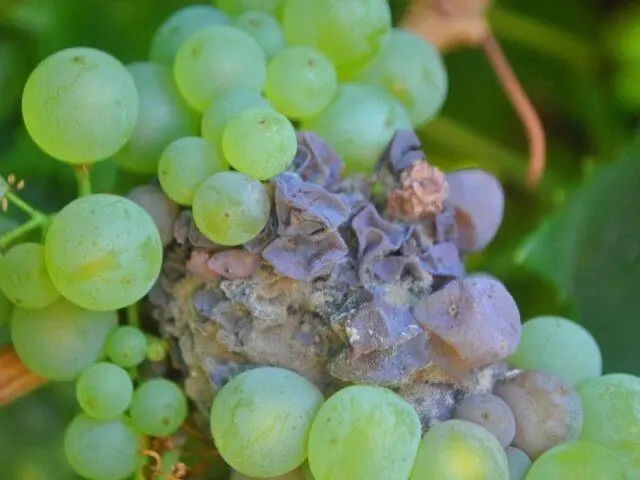
Gray rot spreads very quickly from one grape to another, whole brushes disappear
Causes
There are a lot of ways to get spores of gray rot fungus on grapes. They are easily carried over long distances by wind, insects, birds, and animals. Sometimes the gardener himself becomes a “peddler”, neglecting the disinfection of equipment, tools, work gloves.
The vine can “pick up” the disease from plants already affected by the pathogen located in the area near it. Gray rot is distinguished by a rare “omnivorousness”, the vast majority of horticultural crops, both fruit-bearing and ornamental, can suffer from it. There is always a risk of acquiring already infected seedlings.
There are certain risk factors that increase the likelihood of gray mold infection:
- mechanical damage to the bark on the vines and the skin on the berries;
- nutritional deficiencies, improper and / or untimely feeding;
- intense heat and prolonged;
- excessive “crowding”;
- neglect of regular sanitary and formative pruning;
- contact of leaves and clusters with the soil surface;
- “storage” of plant debris in the garden.
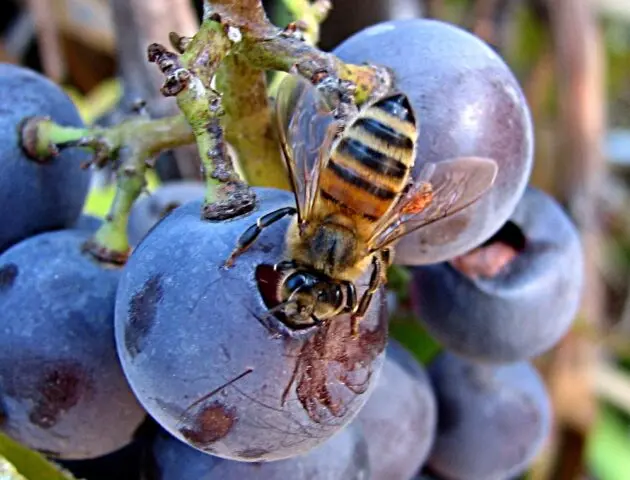
Any damage to the skin is a “gateway” for gray rot
Sometimes growers intentionally infect grapes with gray (so-called “noble”) rot shortly before harvest. This provides for the production technology of elite white dessert wines. The fruits affected by the fungus quickly dry out and “raisin”, which provides the juice with the required thick consistency and sweetness.
On grapes used for the production of red wines, gray rot is unacceptable in any form. The fungus destroys the anthocyanins that give the wort its characteristic color.
What does gray mold look like on grapes?
The main sign of gray rot on grapes is a “fluffy” silver-gray coating on any above-ground part of the plant. Small black “grains” are noticeable in it.
The “associated” symptoms of gray rot depend on what exactly is affected by the fungus:
- Grayish-brown “weeping” spots appear on the leaves. They quickly dry out and fall off.
- On the vines, some areas of the bark are discolored. Gradually they expand, it is easily removed in whole layers. The absence of normal coloration with gray rot turns into tissue necrosis, the shoots dry out and die.
- The flowers turn pale, then turn brown. The pedicels dry up, they massively fall off.
- The development of fruit brushes is strongly inhibited, they are deformed. The berries are covered with small “watery” spots, the skin darkens, they become slimy to the touch. Grapes completely rot or “mummify” and fall off.
- On the ridges, the areas of tissues affected by gray rot change color to brown-green. These spots “blur”, they decay and die, which leads to the cessation of ripening of berries in the brush and their fall.
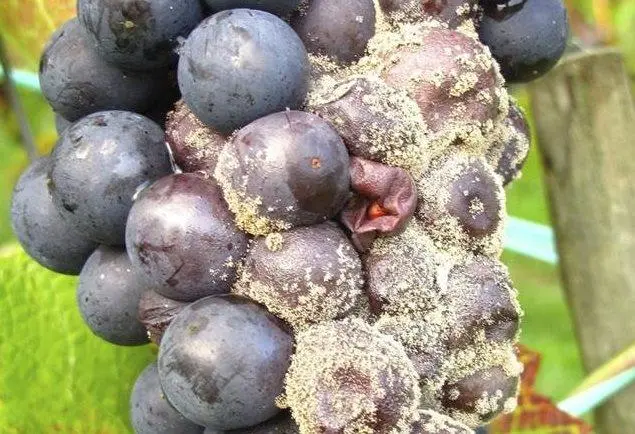
Gray rot can appear not only during the ripening of berries, but also after harvesting – during its transportation and storage.
How to process grapes from gray rot
The range of means for processing grapes from gray rot is quite wide. This is both “heavy artillery” in the form of “aggressive” chemicals, and safer drugs of biological origin. In the early stages of infection, even folk remedies sometimes help to cope with the problem.
Folk remedies
The main advantage of folk remedies is their safety for human health, flora and fauna. Accordingly, such control measures against gray mold of grapes can be practiced at any time, even shortly before harvest.
Grapes infected with gray rot can be processed:
- Onion or garlic infusion. Approximately 200 g of finely chopped “arrows”, “feathers” or the heads themselves are poured into 1 liter of hot water, insisted for 3-4 days, shaking occasionally. Then the liquid is filtered, diluted with water 1:2.
- Iodine solution. For 10 liters of water you need ten drops.
- Kefir, whey, curdled milk. The product is diluted with water 1:5, if desired, iodine can be added.
- Infusion of dry mustard. Powder (50 g) is poured into 5 liters of water, insisted for two days. Before use, filter, add another 5 liters of water.
- A solution of baking soda or soda ash. Working solution – 70-80 g per 10 liters of water.
- Pale pink solution of potassium permanganate (2-3 g per 10 liters of water).
- Foam laundry or green potash soap. In 10 liters of water, beat 40-50 g of small chips.
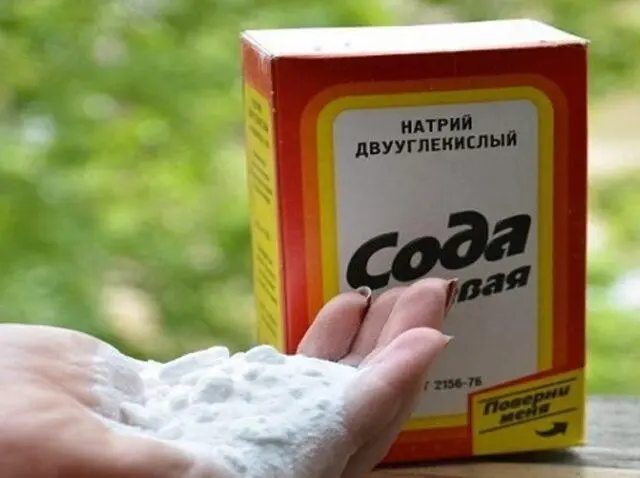
A solution of soda not only destroys gray rot, but also increases the sweetness of berries
Preparations for gray rot on grapes
“Classic” preparations against gray rot on grapes are copper sulfate, Bordeaux liquid and potassium iodide. For plants and the environment, they are relatively safe, but it is still recommended to stop processing the vines 3-4 weeks before harvest.
Against gray rot, a 3% solution of these drugs is used. During processing, it is mandatory to use personal protective equipment for the eyes and respiratory organs, gloves, tight clothing and footwear, which excludes the ingress of liquid on the skin.
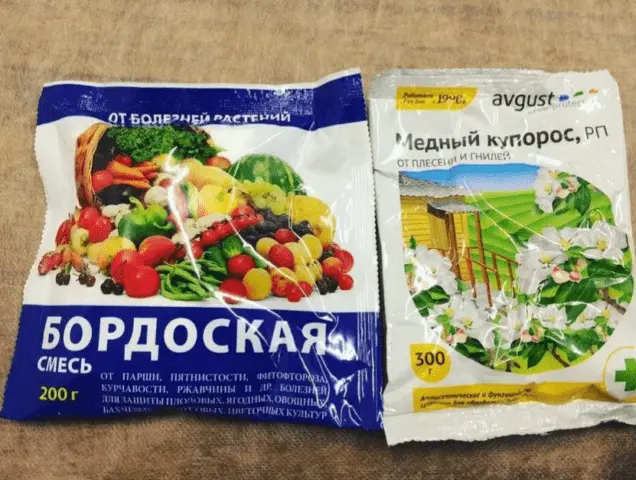
A working solution against gray rot is prepared strictly following the manufacturer’s instructions.
Fungicides for gray mold on grapes
Fungicides are destructive not only for gray rot, but also for any pathogenic fungi. They are divided into chemical and biological. The former are more effective, they begin to act faster. But their use is impossible if less than a month is left before the grape harvest. Some copper-containing preparations against gray rot cannot be used at the budding and flowering stage.
Ridomil Gold
Provides grapes with protection against all types of rot, mildew and fomopsis. It is used for prevention or in the early stages of the development of the disease. The fungus cannot develop resistance to it. If the instructions for use are violated, it poses a danger to humans, flora and fauna, accumulates in the soil.
A significant drawback of the Ridomil-Gold preparation is that after each rain, re-treatment from gray rot is required.
Topaz
It is used mainly against oidium, but is also effective when grapes are infected with gray rot. It begins to act almost immediately – being absorbed into the tissues, it inhibits the activity of the fungus and destroys the mycelium. Does not affect the development of the vine, the ripening of berries.
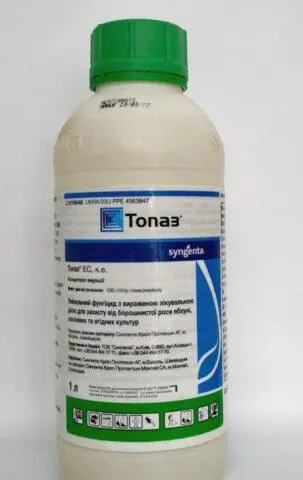
Topaz is well combined with most fungicides, enhancing and prolonging the effect of treatment with them.
Kvadris
Fungicide against all the most dangerous diseases for grapes – mildew, oidium, gray rot. The tool literally “blocks oxygen” to the pathogen. The mycelium of the fungus begins to die massively within an hour after spraying. It takes about two days to completely get rid of gray rot on grapes. Not compatible with herbicides.
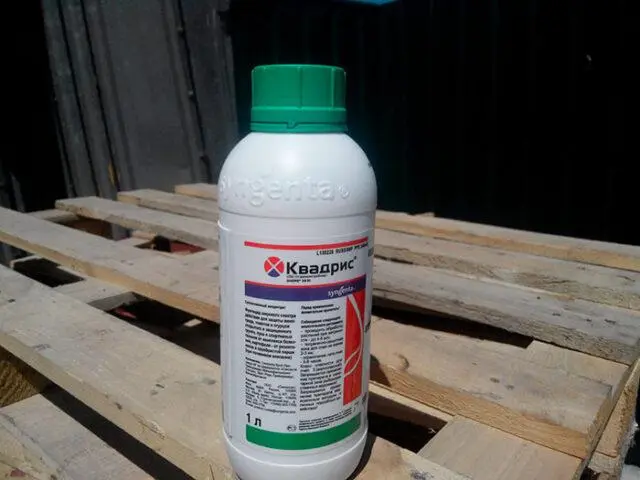
Quadris not only destroys gray rot, but also has a positive effect on the appearance and taste of grapes.
Agricultural practices
Often, the gardener himself becomes the “culprit” of infecting grapes with gray rot. To avoid this, it is necessary to study in advance the important nuances of agricultural technology:
- The right choice of location for grapes. Good lighting, access to fresh air and the quality of the substrate are especially important.
- Providing plants with enough space to feed. With a deficiency of nutrients, their immunity is reduced.
- Regular sanitary pruning in autumn and spring. For this, only sharply sharpened, disinfected tools are used, the cuts are made even, they are immediately covered with garden pitch. All waste generated is incinerated. Do the same with weeds.
- Formation of a high trunk when growing grapes on a trellis. This eliminates the contact of leaves and brushes with the soil, provides good aeration of the plant.
- Weekly inspections of the vineyard. When symptoms resembling gray rot appear, all parts of the plant affected by it are cut and destroyed.
- Refusal of excessive passion for nitrogen-containing fertilizers. With their excess, the green mass begins to “fatten”, the immunity of the vine falls.
- Ventilate immediately if gray mold appears on grapes growing in a greenhouse. If you do not reduce the humidity, any measures to combat it will not have an effect.
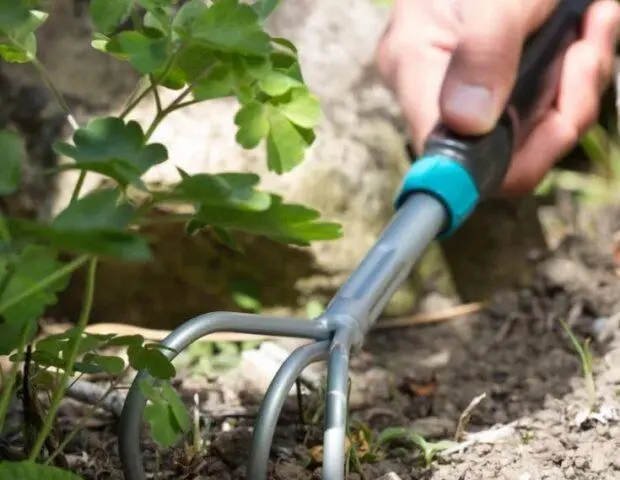
Loosening is necessary to destroy the spores of the fungus in the soil
Prevention
Preventing gray rot infection in grapes is much easier than treating vines later. Prevention is not particularly difficult:
- Carrying out two treatments with fungicides at the beginning and at the end of the active growing season.
- Buying seedlings from nurseries and other “official organizations” that guarantee their quality.
- Careful cleaning of plant debris every autumn, deep loosening of the soil.
- Disinfection of garden tools and tools, substrate and containers used for grape propagation.
- Installation of protective nets from birds and wasps to avoid mechanical damage to the berries.
- Removal of leaves in contact with the soil, garter of low-lying bunches of grapes.
- Regulation of the frequency and rate of irrigation, taking into account the intensity of natural precipitation.
- Timely application of fertilizers containing macro- and microelements necessary for grapes at this stage of development.
- Refusal to use cuttings from gray mold-infected vines as grafting material.
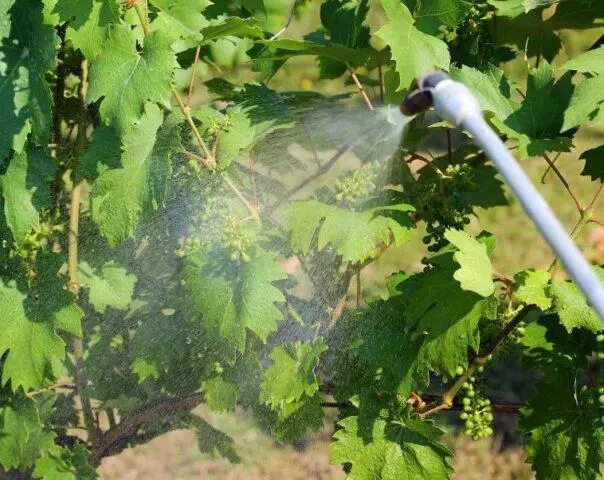
Preventive treatments with fungicides are needed even for gray rot-resistant grape varieties
Grape varieties resistant to gray rot
Grapes that are XNUMX% resistant to gray rot do not yet exist. So far, breeders have only managed to create varieties that are very resistant.
Flora
The vines of Flora grapes are medium-sized, the brushes are very large (about 1 kg, with quality care – up to 2,5 kg). The berries are elongated, greenish-white, with a pinkish “tan”, weighing 8-10 g. The pulp is very juicy and sweet, almost “crispy”. Variety of universal purpose, resistant to mildew, powdery mildew and gray rot.
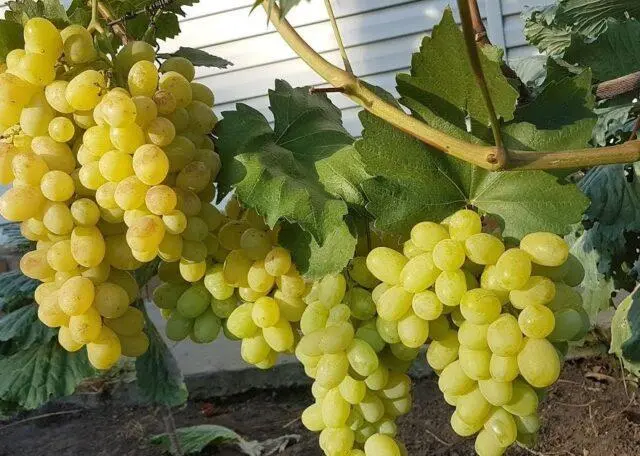
Despite the large size, there are only 2-3 small seeds in Flora grapes.
Bogatyanovsky
A variety of table grapes of early ripening. The vine is vigorous, leaves with pronounced “bristles”. Classical brushes, weighing about 400 g. Berries are greenish-yellow, elongated, weighing 4-5 g. The pulp is very juicy, with a pronounced “cartilage”. Grapes are valued for good keeping quality, transportability, high resistance to mildew and gray rot.
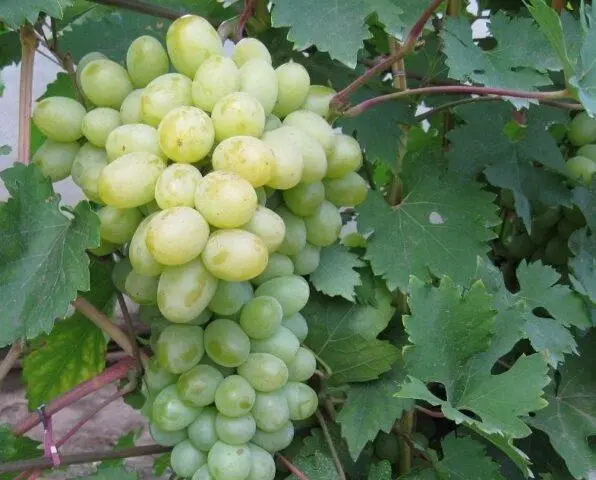
The sweet taste of Bogatyanovsky grapes was rated by professional tasters at nine points out of ten
Agat Donskoy
Vigorous grapes with fast ripening shoots. Leaf blades are slightly wrinkled. The mass of clusters varies from 500 g to 1 kg, the shape of the berries is from round to oval. They weigh an average of 5 g. The skin is thin, but strong, blue-violet, with a pronounced wax coating. Berries can be eaten fresh, processed into raisins or wine, frozen. The variety is valued for frost resistance down to -26 ° C, the ability to adapt to the local climate and weather, high resistance to mildew and gray rot.
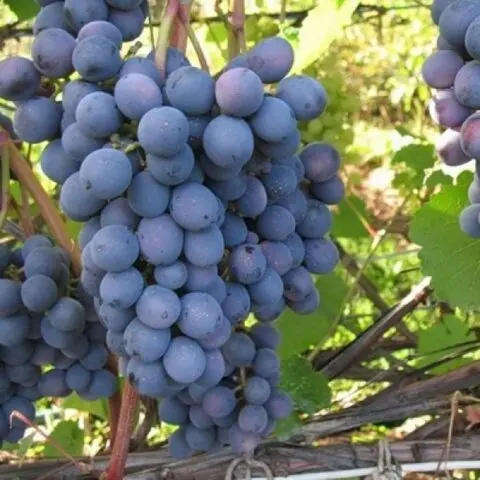
The relative disadvantage of Agat Donskoy grapes is the exactingness of cultivation conditions and soil fertility
Pleven
Early ripe grapes mainly for the southern regions. Resistant to fungal diseases, including gray rot, pests. Wasps are not too interested in them. The bushes are tall, characterized by rapid growth. The brushes are cone-shaped, weighing 300-350 g. The berries are greenish-yellow, with a pinkish “blush”. The skin is thin, the flesh is tender and juicy. The taste is pronouncedly sweet, with hints of nutmeg. Grapes can be eaten fresh, dried, used for home canning.
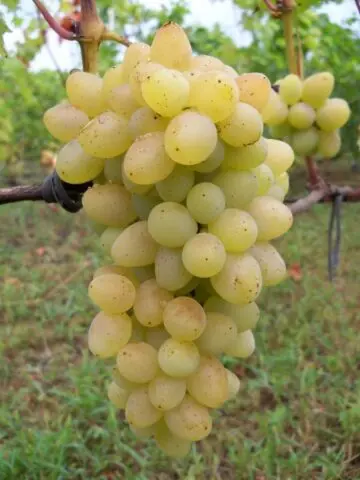
Due to the presence of bisexual flowers, Pleven grapes do not need “outside help” for pollination.
Pineapple
A variety used primarily in winemaking. It owes its name to the characteristic pineapple aroma and taste of pulp. It is highly resistant to mildew and gray mold. Vines of medium height and vigor. Clusters are medium-sized (up to 300 g), cylindrical. The skin is thin, rich yellow-green hue, the flesh is tender and sweet. In central Our Country, this grape does not need shelter, it is unpretentious in care, valued for keeping quality and transportability, consistently high yields.
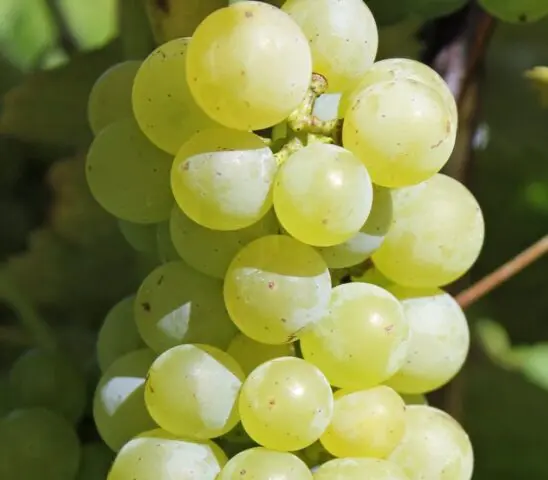
Pineapple grapes are extremely rarely attacked by wasps and aphids
Violet early
An early ripe variety that does not need shelter for the winter in a temperate climate. Harvest ripens in early August. The vines are tall, vigorous. Flowers bisexual. The brushes are small (about 200 g), cone-shaped. The berries are round-oval, weighing 4-5 g. The skin is elastic, densely purple in color, with a pronounced waxy coating. The grapes are very sweet, with a strong nutmeg aroma and aftertaste. The variety has a high immunity to any pathogenic microflora.

Grapes Violet early suitable for squeezing juice, it is used as a “raw material” for homemade wines and champagne
Conclusion
Gray rot of grapes, if nothing is done, may well destroy not only the crop of the current season, but also the vines themselves. However, there are simple preventive measures that significantly reduce the risk of developing this disease. When gray mold infection cannot be avoided, folk remedies can help in the early stages. In advanced cases, you have to resort to the help of fungicides and other drugs.









